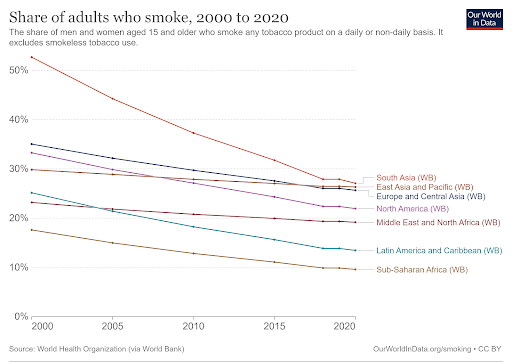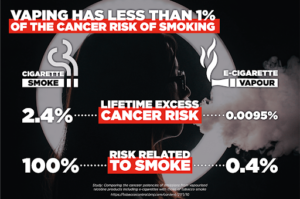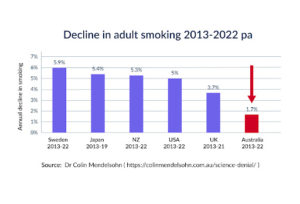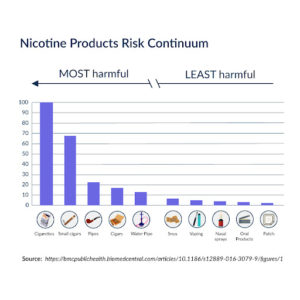Pušenje je globalni problem. Postoji otprilike 1,3 milijarde korisnika duhana u svijetu. Do sada su se tradicionalni pristupi prestanku pušenja pokazali uvelike neučinkovitima. Od pionirskog razvoja alternativnih proizvoda za pušenje na bazi nikotina, svjedočili smo ogromnom napretku u smanjenju stope pušenja diljem svijeta. Primjerice, Švedska, zemlja s dugom tradicijom promocije snusa, ali i nikotinskih vrećica i vapinga, slavi se kao prva zemlja na svijetu koja je postala zemlja bez pušenja. Ujedinjeno Kraljevstvo smanjilo je stopu pušenja za gotovo 501 TP4T između javne podrške vapingu od strane Javnog zdravstva Engleske 2015. i 2021., sada pokreće nacionalni program kojim se potiče pušače da prestanu pušiti cigarete zamjenom za besplatnu e-cigaretu. Smanjenje štete pokazalo se pokretačkom snagom u globalnoj borbi protiv pušenja.

Ovaj informativni list ima za cilj osvijetliti pitanje vapinga i smanjenja štete od duhana, nudeći sveobuhvatan pregled najrelevantnijih i najnovijih znanstvenih istraživanja i regulatornih politika diljem svijeta.
Što je smanjenje štete?
Smanjenje štete ima za cilj minimizirati negativne utjecaje aktivnosti. Baš kao što sigurnosni pojasevi i kacige povećavaju sigurnost tijekom vožnje, smanjenje štete traži praktična rješenja umjesto nerealnih ideala. Daje prioritet izvedivim načinima za učinkovito ublažavanje rizika.
Zašto je smanjenje štete od vapinga?
Što se tiče smanjenja štete od duhana, vaping se ističe kao odličan primjer. Iako potpuna apstinencija može biti ono čemu neki potrošači teže, često je nedostižna. S obzirom na široko rasprostranjenu potražnju za nikotinom, o čemu svjedoči postojanje milijuna pušača, vaping nudi način odvajanja konzumacije nikotina od najštetnijih aspekata pušenja. Iako nije potpuno bez rizika, vaping značajno smanjuje štetu u usporedbi s pušenjem, što ga čini vrijednom alternativom za pušače koji žele ublažiti svoj osobni rizik.
Je li vaping manje štetan od pušenja?
Da. Postoje daleko preko 100 organizacija i vladinih institucija koji se slažu da je vaping manje štetan od pušenja.
Pomaže li vaping pušačima da prestanu pušiti?
Da. Novi sustavni pregled dokaza koji uključuje 78 završenih studija britanske nevladine organizacije za javno zdravstvo, Cochrane, potvrdio je da vaping pomaže pušačima da prestanu pušiti. Cochraneovi sustavni pregledi globalno su prepoznati kao zlatni standard u zdravstvenim dokazima.
Kako bi trebalo regulirati vaping?
Ono što nam treba je regulacija temeljena na riziku. Vaping je manje štetan od pušenja.
i ne smiju se tretirati na isti način. Manje štetne alternative trebale bi biti manje regulirane od najštetnijeg proizvoda na tržištu - cigareta.
U nastavku su navedene najrelevantnije studije sastavljene u sljedećim područjima:
Svako poglavlje na kraju sadrži odjeljak s popisom literature u kojem su sažeti svi citirani akademski članci.
Istraživanja su pokazala da, iako nije potpuno bezopasno, vaping je puno manje štetan od pušenja. Rizik od raka u usporedbi s pušenjem praktički ne postoji. Evo glavnih dokaza o zdravstvenim učincima vapinga u usporedbi s pušenjem:

Postoji dovoljno dokaza da se zaključi ne samo da vaping pomaže u prestanku pušenja, već i da je vaping jedno od najučinkovitijih pomagala za to. Vaping je... preporučeno sredstva za prestanak pušenja za pušače u Francuska, the Velika Britanija, Kanada, i Novi Zeland; i to je bilo ključno u smanjenju stope pušenja u zemljama koje imaju pristup tome utemeljen na dokazima, kao što je u Velika Britanija, gdje je pušenje na najnižoj razini ikad. Evo primarnog istraživanja:

Do danas je vaping najučinkovitija pomoć pri prestanku pušenja, kako je zaključila visoko cijenjena zdravstvena nevladina organizacija Cochrane u svojoj najnovijoj meta-analizi koju je provela Lindson i sur. (2023.).
Vaping kao ulazna točka za adolescente u pušenje jedan je od najzabrinjavajućih mitova u kontroli duhana. Međutim, postoji malo ili nimalo dokaza koji ukazuju na vezu između vapinga kod mladih i konvencionalnog pušenja. Postoje mnogi Drugi razlozi zašto mladi puše. Pogledajmo što je znanost uspjela pokazati:
Osim nedostatka dokaza koji povezuju korištenje e-cigareta među mladima s pušenjem, podaci pokazuju da su i stope pušenja i korištenja e-cigareta među mladima u padu u mnogim zemljama posljednjih godina. Podaci organizacije Action on Smoking and Health (ASH) UK pokazuju da Stopa pušenja među mladima je na najnižoj razini ikad i podatke iz Ured za nacionalnu statistiku pokazuje da je korištenje e-cigareta među mladima rijetko među onima koji nikada nisu pušili. Većina korisnika su sadašnji ili bivši pušači. U SAD-u, gdje često čujemo o takozvanoj "epidemiji vapinga", korištenje e-cigareta među mladima pao značajno u proteklim godinama.
Prof. Polosa i dr. (2022.)²⁵ sažeo je obrazac korištenja vapinga među mladima kao: “Korištenje endokrinola znatno je poraslo među srednjoškolcima i mladim odraslim osobama u posljednjem desetljeću, ali srećom značajno je pala od vrhunca 2019. Tijekom istog razdoblja, stope pušenja stalno su padale na nove niske rekordne razine. Ovi trendovi govore protiv korištenja endokrinola kao ulazne točke u pušenje. Većina korištenja endokrinola je rijetka i vjerojatno neće povećati rizik od negativnih zdravstvenih posljedica. Nadalje, većina korištenja endokrinola dogodila se među onima koji su prethodno pušili.” Nema efekta prolaza na vidiku.
Arome su jedna od najspornijih tema kada je u pitanju javna politika o vapingu. Općeprihvaćeno je mišljenje da su arome namijenjene tinejdžerima, a odrasli ih rijetko koriste. Međutim, velik broj istraživanja utvrdio je njihovu važnost za odrasle koji pokušavaju prestati pušiti, a postoje i brojni dokazi da zabrane aroma čine više štete nego koristi.
Evo dokaza o okusima vapinga:
Friedman i Xu (2020.),²⁶ istraživači s Yale School of Public Health povezali su korištenje okusa za vaping s povećanjem vjerojatnosti prestanka pušenja kod odraslih osoba i zaključili da: “Odrasli koji su koristili e-cigarete s okusom vaporiziranih proizvoda imali su veću vjerojatnost da će kasnije prestati pušiti od onih koji su koristili e-cigarete bez okusa. (...) Odrasli koji su počeli koristiti e-cigarete bez okusa duhana imali su veću vjerojatnost da će prestati pušiti od onih koji su koristili e-cigarete s okusom duhana.”
Mendelsohn (2017.),²7 u podnesku Odboru australskog Zastupničkog doma izjavio je da okusi vjerojatnije odvraćaju ljude od tradicionalnih cigareta, budući da im pomažu da zaborave okus duhana: “Okusi su važan dio privlačnosti vapinga za odrasle pušače i čine proizvode privlačnima kao alternativa pušenju, baš kao što se okusi koriste i za poboljšanje privlačnosti nikotinske žvakaće gume. Zabrana okusa vjerojatno bi potkopala upotrebu e-cigareta i javno zdravlje.”
Friedman (2020.)²⁸ analizirao je učinke zabrane aroma u San Franciscu i otkrio da je to prvi put u desetljećima rezultiralo porastom stope pušenja među tinejdžerima.
Bogat (2022.)²⁹ analizirali su učinke zabrane aroma u Massachusettsu i zaključili da je to rezultiralo većom prodajom cigareta.
Gravely i sur. (2020.)³⁰ anketirali su korisnike aroma koje nisu duhan u Kanadi, Ujedinjenom Kraljevstvu i Sjedinjenim Državama koji koriste e-cigarete te otkrili da bi, u slučaju zabrane aroma, 5 od 10 nabavilo svoje arome s tržišta ili ponovno počelo pušiti.
The Zaklada Tholos (2022.)³¹ analizirali su učinke zabrane aroma u Estoniji i otkrili da 60% vapera nastavlja koristiti tekućine miješajući ih sami ili nabavljajući ih s crnog tržišta.
Friedman i sur. (2023.)³² proučavali su ograničenja aromatiziranih ENDS-ova diljem Sjedinjenih Država i procijenili kompromis od 15 dodatnih cigareta za svaku prodanu ENDS kapsulu manje od 0,7 mL zbog ograničenja okusa ENDS-a. Autori su zaključili da “sve koristi za javno zdravstvo od smanjenja upotrebe ENDS-a putem ograničenja okusa mogu biti poništene troškovima javnog zdravstva zbog povećane prodaje cigareta.”
Kao što je EU SCHEER (2021.) izvješće je zaključilo: “Do danas ne postoje konkretni podaci o tome da određene arome koje se koriste u EU predstavljaju zdravstveni rizik za korisnike elektroničkih cigareta nakon ponovljene izloženosti.”
Mnogi kreatori politike smatraju da su porezi na elektroničke sustave za isporuku nikotina (ENDS) instrument koji može smanjiti korištenje vapinga i poboljšati javno zdravlje. Unatoč tome, većina dokaza pokazuje da povećanje poreza na e-cigarete potiče vapere da ponovno počnu pušiti.
Porezi na alternativne proizvode trebali bi se odrediti u skladu s njihovim rizikom u odnosu na rizik cigareta. S gledišta poticaja, nema smisla oporezivati tradicionalne i elektroničke cigarete na isti način. Porezi na tradicionalne cigarete namijenjeni su pokrivanju troškova zdravstvene zaštite i negativnih eksternalija koje proizlaze iz pušenja. Budući da je vaping manje štetan za korisnika i nema negativne učinke na ljude oko njega, samo je proporcionalno da su i porezi niži. To neće biti dovoljno samo za pokrivanje troškova zdravstvene zaštite koje proizlaze iz vapinga, već će razlika u cijeni u odnosu na tradicionalne cigarete biti još jedan poticaj pušačima da pređu na druge proizvode i poboljšaju javno i vlastito zdravlje.
Općenito se vjeruje da je nikotin štetan, a ideja da vaping nikotinskih proizvoda uzrokuje rak jednako je raširena. Stoga se često tvrdi da je vaping nikotina jednako štetan kao i pušenje. Unatoč činjenici da para e-cigareta ne sadrži najštetnije elemente duhanskog dima, poput katrana ili ugljičnog monoksida, vjeruje se da i dalje uzrokuje rak. Međutim, dokazano je da je nikotin relativno bezopasan:
George (2019.)³⁹ proučavali su kardiovaskularne učinke prelaska s pušenja na vaping i otkrili da oni koji pređu poboljšavaju svoje zdravlje bez obzira nastavljaju li konzumirati nikotin ili ne.
Foulds i dr. (2021.)⁴⁰ otkrili su da je nikotin važan faktor u tome mogu li pušači prijeći na vaping. Autori su otkrili da je vaping “s dozom nikotina koja se približava onoj u cigareti, učinkovitiji su u pomaganju ambivalentnim pušačima da prestanu pušiti cigarete.”
Niaura (2016.)⁴¹ izjavio da “Većina fiziološke štete koja se može pripisati pušenju cigareta proizlazi iz toksina u duhanu i produktima izgaranja. Morbiditet i mortalitet koji se mogu spriječiti u velikoj su mjeri povezani s pušenjem duhana nakon izgaranja, a ne sa samim nikotinom. Odvojen od izgaranja ili drugih toksičnih načina isporuke, nikotin je sam po sebi mnogo manje štetan.”
Stav da nikotin nije štetna komponenta u duhanskim proizvodima podržalo je nekoliko zdravstvenih organizacija. Britanska Nacionalna zdravstvena služba, slijedeći pragmatičan pristup konzumaciji nikotina i vapingu, izjavio je da: “Iako je nikotin ovisna tvar u cigaretama, relativno je bezopasan. Gotovo sva šteta od pušenja dolazi od tisuća drugih kemikalija u duhanskom dimu, od kojih su mnoge otrovne.”
Slično tome, Istraživanje raka u Yorkshireu izjavio/la: “Nikotin nije uzrok smrti od pušenja. Nikotin nije kancerogen; nema dokaza da dugotrajna upotreba nikotina sama po sebi povećava rizik od raka. Od tri glavna uzroka smrti od pušenja (rak pluća, kronična opstruktivna plućna bolest i kardiovaskularne bolesti), nijedan nije uzrokovan nikotinom. Šteta od pušenja dolazi od tisuća drugih kemikalija u duhanskom dimu.”
Shirley Cramer, glavna izvršna direktorica Kraljevskog društva za javno zdravstvo, rekao: “Prelazak ljudi na nikotin umjesto na duhan uvelike bi promijenio javno zdravlje – očito postoje problemi s ovisnošću pušača o nikotinu, ali to bi nas odmaknulo od ozbiljnog i skupog problema javnog zdravstva, od bolesti povezanih s pušenjem do…“ umjesto toga pozabavite se pitanjem ovisnosti o tvari koja sama po sebi nije previše različita od ovisnosti o kofeinu.”
Snus:
Snus je vrećica duhana u obliku vlažnog praha bez dima, nastala u Švedskoj, a koristi se stavljanjem ispod gornje usne. Upotreba snusa nadmašila je pušenje zapaljivih cigareta u Švedskoj. Švedska je na putu da postane prva zemlja koja će postići cilj zabrane pušenja, s trenutnom stopom pušenja od 5,61 TP4T. Iako je ukupna konzumacija nikotina u Švedskoj u sličnom rasponu kao i u drugim europskim zemljama, smrtnost povezana s pušenjem je mnogo niža, što pokazuje... Clarke i sur. (2019.).⁴²
Ključne činjenice:
Nikotinske vrećice:
Nikotinske vrećice najnovija su alternativa pušenju i stoga još nisu adekvatno regulirane u mnogim zemljama. Nikotinske vrećice koriste se slično kao snus, ali za razliku od snusa sadrže nikotinski prah umjesto lista duhana. Trenutno su ili neregulirane, potpuno zabranjene ili se tretiraju isto kao i cigarete u većini zemalja - i nijedna od ovih alternativa nije optimalna. Uz regulaciju prilagođenu potrošačima, nikotinske vrećice mogle bi biti kamen temeljac našeg marša prema populaciji bez dima.
Ključne činjenice:
Alternativni nikotinski proizvodi imaju potencijal smanjiti stopu pušenja i poboljšati javno zdravlje. Dokaz za to je da zemlje s relativno visokim stupnjem prihvaćanja alternativnih nikotinskih proizvoda poput vapinga, grijanog duhana, nikotinskih vrećica i snusa općenito brže smanjuju stopu pušenja od zemalja koje se suzdržavaju. Ujedinjeno Kraljevstvo i Švedska dokazuju da se niže stope pušenja mogu postići otvorenim pristupom alternativnim nikotinskim proizvodima.
Ujedinjeno Kraljevstvo: pomoć pušačima pri prelasku na drugi lijek
Ujedinjeno Kraljevstvo je najnaprednija zemlja na svijetu kada je u pitanju vaping. Vlada i javne zdravstvene ustanove u potpunosti podržavaju vaping kao alat za smanjenje štete, a pušače se potiče da pređu na ovu manje štetnu alternativu. U Ujedinjenom Kraljevstvu, Stopa pušenja pala je za više od 29% u posljednjem desetljeću (kada je vaping postao popularan). U usporedbi s EU, stope pušenja u Ujedinjenom Kraljevstvu pale su dvostruko brže, prema Fagerström (2022.).⁴⁶ Ove je godine Ujedinjeno Kraljevstvo pokrenulo program 'Swap-to-Stop', dosad najveću vladinu strategiju prestanka pušenja korištenjem e-cigareta.
Švedska: postaje prva zemlja bez pušenja uz pomoć snusa
U Švedskoj je upotreba snusa premašila pušenje samozapaljivih cigareta, uglavnom zbog prelaska pušača na njega. Zahvaljujući zamjeni duhana ovom sigurnijom alternativom, Švedska je na putu da postane prva zemlja koja će postići cilj bez dima, sa stopom pušenja od 5,6% od 2023. godine. Iako je ukupna konzumacija nikotina u Švedskoj u sličnom rasponu kao i kod njihovih europskih susjeda, smrtnost povezana s pušenjem je mnogo niža, što pokazuje... Clarke i sur. (2019.),47 što dokazuje da je snus mnogo manje štetan proizvod koji može poboljšati javno zdravlje u cjelini. Švedska sada želi ubrzati taj proces smanjenjem poreza na snus do 20%.
Japan: proizvodi koji se zagrijavaju, a ne gore, smanjuju stopu pušenja
Proizvodi koji se zagrijavaju bez izgaranja (HnB) zagrijavaju duhan i stvaraju aerosol koji se može udisati umjesto da ga sagorijevaju kao tradicionalne cigarete. Simonavicius i dr. (2019.) utvrđeno je da ih nedostatak izgaranja čini znatno sigurnijima od tradicionalnih cigareta.⁴⁸ Zbog njihovog uvođenja i popularizacije u Japanu, u samo pet godina (2016.-2021.), prodaja cigareta pala je za 43%. Sve više ljudi u Japanu odbija cigarete i bira manje štetne alternativne proizvode poput onih koji se ne zagrijavaju. Stopa HnB-a u Japanu trenutno iznosi oko 4,5%, a Istraživanje o zdravlju i prehrani pokazalo je da 76% korisnika HnB-a više uopće ne puši cigarete.
Novi Zeland: osvještavanje pušača o sigurnijim alternativama
Pružanje točnih informacija pušačima o alternativnim proizvodima može im pomoći u donošenju boljih odluka i poboljšanju zdravlja. Ministarstvo zdravstva Novog Zelanda najbolji je primjer komunikacije o vapingu. Web stranica Činjenice o vapingu, koju također podržava većina javnozdravstvenih organizacija na Novom Zelandu, pruža točne zdravstvene informacije, savjete za prestanak pušenja, telefonsku liniju za pomoć i mogućnosti osobne podrške. Dok druge zemlje šire dezinformacije i ignoriraju opsežna istraživanja koja podupiru vaping kao metodu prestanka pušenja, Novi Zeland brzo povećava stopu pušenja pružajući pušačima dobre informacije.
Na temelju znanstvenih dokaza i uspješnih vladinih politika poput onih u Švedskoj i Ujedinjenom Kraljevstvu, Svjetski savez vapera predlaže provedbu sljedećih pristupa na institucionalnoj razini:
Jasna predanost konceptu smanjenja šteteCilj smanjenja štete je smanjenje negativnih posljedica među osobama koje nastavljaju koristiti nezdrave proizvode. Razvijen je kao odgovor na neuspješan “pristup nulte tolerancije”. Umjesto idealiziranih ciljeva, smanjenje štete stavlja praktična rješenja u središte pozornosti. Smanjenje štete pokazalo se učinkovitim i prihvaćeno je u mnogim zemljama.
Potaknite trenutne pušače da pređu na vaping i slične manje štetne proizvode: Poput vlada Francuske, Ujedinjenog Kraljevstva, Kanade i Novog Zelanda, pomažu pušačima u njihovim nastojanjima da prestanu pušiti promovirajući vaping kao manje štetnu alternativu cigaretama.
Osigurati pristup proizvodima za vaping za odrasle i spriječiti zabrane okusaKljučno je osigurati pristupačnost i raznolikost. Zabrane okusa naštetile bi javnom zdravlju gurajući milijune korisnika vapinga natrag pušenju ili crnom tržištu.
Regulacija i oporezivanje temeljeni na riziku: Trebalo bi provesti moderan, otvoren regulatorni okvir temeljen na riziku usmjeren na smanjenje štete od duhana. Vaping nije pušenje i ne smije se tretirati isto. Budući da je vaping manje štetan od pušenja, trebao bi biti manje strogo reguliran i manje oporeziv od cigareta. Isto vrijedi i za druge manje štetne alternative poput nikotinskih vrećica, snusa i proizvoda koji se ne zagrijavaju i ne gore.

Vaping ima potencijal osigurati da 200 milijuna pušača zauvijek prestane pušiti, ali vlade ga moraju poticati i olakšavati kao metodu prestanka pušenja. Sada je više nego ikad ključno da se čuju glasovi vapera, uključujući nikotinske proizvode niskog rizika poput vapinga.
Zato vodimo našu kampanju diljem Europe i svijeta. Moramo osigurati da oni koji donose ključne odluke koje će utjecati na NAŠA prava, NAŠE zdravlje i NAŠU budućnost čuju NAŠ kolektivni glas i 'Povratite vaping. Pobijedite pušenje.'‘